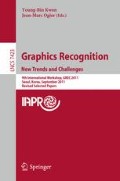Abstract
This paper describes a recognition system for online handwritten Tibetan characters using advanced techniques in character recognition. To eliminate noise points of handwriting trajectories, we introduce a de-noising approach by using dilation, erosion, thinning operators of the mathematical morphology. Selecting appropriate structuring elements, we can clear up large amounts of noises in the glyphs of the character. To enhance the recognition performance, we adopt three-stage classification strategy, where the top rank output classes by the baseline classifier are re-classified by similar character discrimination classifier. Experiments have been carried out on two databases MRG-OHTC and IIP-OHTC. Test results show the used recognition algorithm is effective and can be applied in pen-based mobile devices.
Access this chapter
Tax calculation will be finalised at checkout
Purchases are for personal use only
Preview
Unable to display preview. Download preview PDF.
References
Ding, X.Q., Wang, H.: Multi-font printed Tibetan OCR. In: Advance in Pattern Recognition, pp. 73–98 (2007)
Ngodrup, D.C.Z.: Study on printed Tibetan character recognition. In: Proc. AICI, pp. 280–285 (2010)
Masami, K., Yoshiyuki, K., Masayuki, K.: Character recognition of wooden blocked Tibetan similar manuscripts by using Eucliden distance with deferential weight. IPSJ SIGNotes Computer and Humanities, 13–18 (1996)
Liang, B., Wang, W.L., Qian, J.J.: Application of Hidden Markov Model in on-line Recognition of handwritten Tibetan characters. Journal of Microelectronics & Computer 26(4), 98–101 (2009) (in Chinese)
Wang, W.L., Ding, X.Q., Qi, K.Y.: Study on simlitude characters in Tibetan character recognition. Journal of Chinese Information Processing 16(4), 60–65 (2002) (in Chinese)
Ma, L.L., Liu, H.D., Wu, J.: MRG-OHTC database for online handwritten Tibetan character recognition. In: Proc. 11th ICDAR, pp. 207–211 (2011)
Liu, C.L., Jaeger, S., Nakagawa, M.: Online recognition of Chinese characters: the state-of-the-art. IEEE Trans. Pattern Anal. Mach. Intell. 26(2), 198–213 (2004)
Sun, Y., Liu, H.M., Rui, J.W., Wu, J.: De-noising approach for online handwriting character recognition based on mathematical morphology. Journal of Computer Science 36(10), 237–239 (2009) (in Chinese)
Sun, Y.: The study on online handwritten Tibetan character recognition. Master Thesis (2009) (in Chinese)
Hamanaka, M., Yamada, K., Tsukumo, J.: On-line Japanese character recognition experiments by an off-line method based on normalization-cooperated feature extraction. In: Proc. 3rd ICDAR, pp. 204–207 (1993)
Gao, T.F., Liu, C.L.: High accuracy handwritten Chinese character recognition using LDA-based compound distances. Pattern Recognition 41(11), 3442–3451 (2008)
Leung, K.C., Leung, C.H.: Recognition of handwritten Chinese characters by critical region analysis. Pattern Recognition 43(3), 949–961 (2010)
Zhou, X.D., Wang, D.H., Nakagawa, M., Liu, C.L.: Error reduction by confusing characters discrimination for online handwritten Japanese character recognition. In: Proc. 12th ICFHR, pp. 495–450 (2010)
Kimura, F., Takashina, K., Tsuruoka, S., Miyake, Y.: Modified quadratic discriminant functions and its application to Chinese character recognition. IEEE Trans. Pattern Anal. Mach. Intell. 9(1), 149–153 (1987)
Zhou, X.D., Liu, C.L., Nakagawa, M.: Online handwritten Japanese character string recognition using conditional random fields. In: Proc. 10th ICDAR, pp. 521–525 (2009)
Bai, Z.L., Huo, Q.: A study of nonlinear shape normalizaiton for online handwritten Chinese character recognition: dot density vs. line density equalization. In: Proc 18th ICPR, pp. 921–924 (2006)
Zhang, T.Y., Suen, C.Y.: A fast parallel algorithm for thinning digital pattern. Communicaition of the ACM 27(6), 236–239 (1984)
Kimura, F., Takashina, K., Tsuruoka, S., Miyake, Y.: Modified quadratic discriminant functions and its application to Chinese character recognition. IEEE Trans. Pattern Anal. Mach. Intell. 9(1), 149–153 (1987)
Author information
Authors and Affiliations
Editor information
Editors and Affiliations
Rights and permissions
Copyright information
© 2013 Springer-Verlag Berlin Heidelberg
About this paper
Cite this paper
Ma, LL., Wu, J. (2013). A Recognition System for Online Handwritten Tibetan Characters. In: Kwon, YB., Ogier, JM. (eds) Graphics Recognition. New Trends and Challenges. GREC 2011. Lecture Notes in Computer Science, vol 7423. Springer, Berlin, Heidelberg. https://doi.org/10.1007/978-3-642-36824-0_10
Download citation
DOI: https://doi.org/10.1007/978-3-642-36824-0_10
Publisher Name: Springer, Berlin, Heidelberg
Print ISBN: 978-3-642-36823-3
Online ISBN: 978-3-642-36824-0
eBook Packages: Computer ScienceComputer Science (R0)

